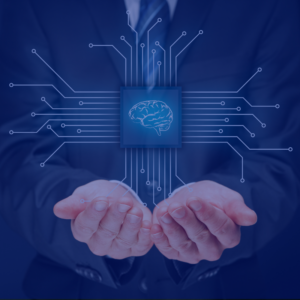Organizations who adopt and exploit automation, robotics, and intelligent systems have a key competitive edge. They’ve understood how human-machine collaboration augments, rather than replaces, our own intelligence and capabilities.
Once Upon A Time There Were Two
The rise of civilization parallels the development of tools that amplify human cognitive and physical abilities. It held true yesterday with the steam engine and mechanical loom, and more recently the personal computer; dubbed “a bicycle for the mind” by visionary Steve Jobs. It remains true today with robots able to mimic the human body, and AI systems that emulate human intelligence.
Organizations use these systems to boost profitability and productivity by automating a wide range of processes. Governments use them to automate public service decision-making, applying it everywhere from delivery to eligibility management.
We’re venturing into a new era of collaboration between humans and the tools they invent, namely machines and AI systems.
A Mindset In Action
AI systems and human-machine collaboration drives innovation and co-innovation across all sectors. They’re applied and active in transportation, commerce, finance, government, manufacturing, education, medicine, and law. Ultimately, they’re creating constructs in which humans and machines work in hybrid real/virtual environments, leveraging information from big data.
Powered by advanced algorithms and large-scale cloud operation capabilities (hyperscale computing), these next-gen organizations are creating the new era of business technology.
While digital transformation reshapes traditional business models and processes, AI systems and human-computer collaboration go even further: they’re transforming human activity and our learning concepts, and so the actual concept of business.
Companies harnessing the full potential of AI systems achieve far more than the automation of their business processes.
Beyond Automation
Companies leveraging artificial intelligence systems:
- Facilitate collaboration between people and systems.
- Invest so humans and systems can better communicate and interact.
- Change to learn, and learn to change.
ADVANTAGES BEYOND AUTOMATION
AI is much more than mere automation – it’s a lever for growth and competitive advantage. It multiplies potential, simplifies processes, and offers business more bang for the buck.
REALIZATION of automated production, control, and supervision tasks when humans require assistance.
SUPPORT in decision-making by performing complex predictive analyses and modeling tasks that involve multiple variables.
SUBSTITUTION in environments deemed too dangerous or hostile for humans.
ASSISTANCE to humans when their capabilities are insufficient to accomplish specific tasks.
CREATION of a personalized customer experience that offers numerous opportunities for customized products and services.
COLLABORATION with humans by generating ideas refined through iterations and pilot projects that lead to innovative solutions.
There exist countless examples where human-machine collaboration feeds the amplification of complementary capacities that go far beyond the robotic automation of physical, decision-making, or business processes.
While companies integrate artificial intelligence systems to automate operations, using these systems solely for generating faster, cheaper growth significantly limits their innovation and transformation potential.
Technology breakthroughs during the past few millennia were driven by the need to perform new tasks, not automating existing ones.
Get On Board Or Stay Ashore
Organizations delaying investment in AI systems will fall behind competitors. And, at the rate at which machine and deep learning, computer vision, speech recognition, and natural language processing technologies are evolving, they may never catch up.
By 2025 AI and machine learning will increase labor productivity by 37%
While robotic automation creates operational efficiency and generates financial returns, human-machine collaboration creates all-new, previously unknown competitive advantages. Whether it’s cost reduction, increased revenue, improved customer experience, increased operational efficiency, or the invention of new services, products, and business models, the companies benefitting most from AI systems base their strategy on the mutual amplification of complementary capabilities.
Organizations which think big, accept failure, and act quickly to improve have a key competitive edge.
It’s understood that organizations leveraging automation, robotics, and intelligent systems have a key competitive edge because they’ve understood how human-machine collaboration augments, rather than replaces, our own intelligence and capabilities.
How?
By thinking big, accepting failure, and acting quickly to improve.





